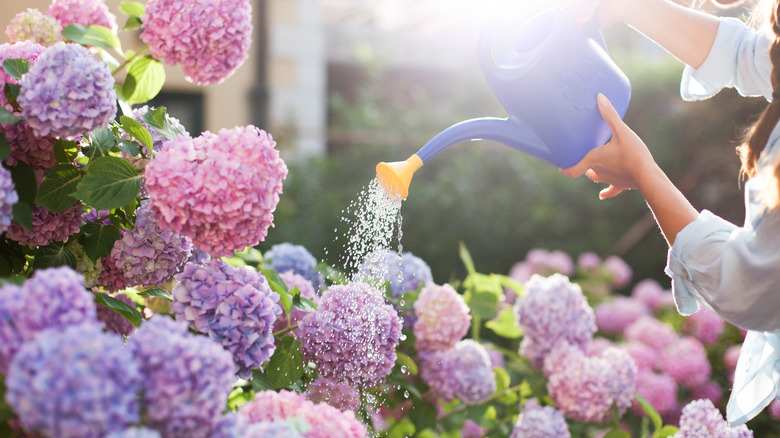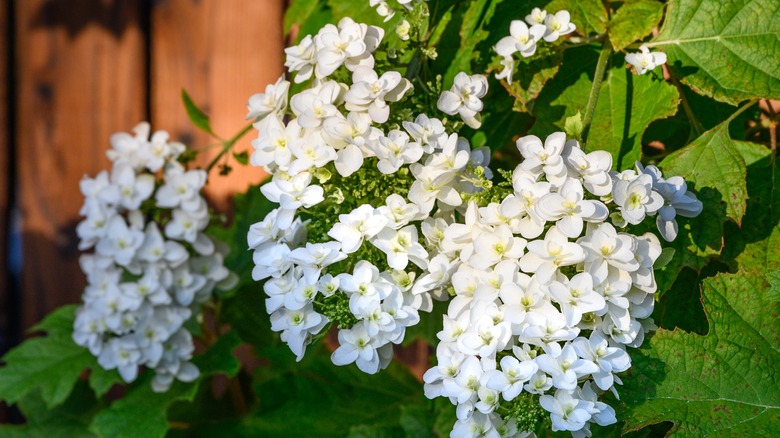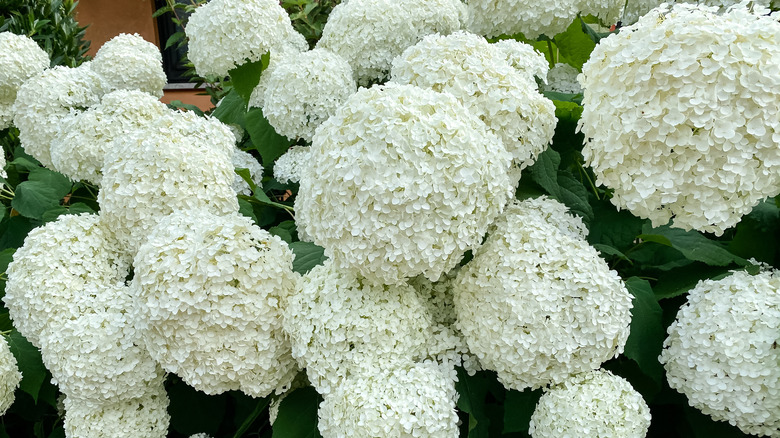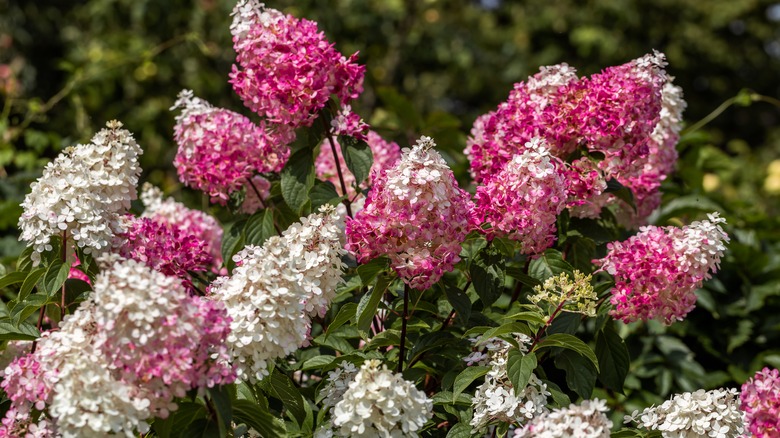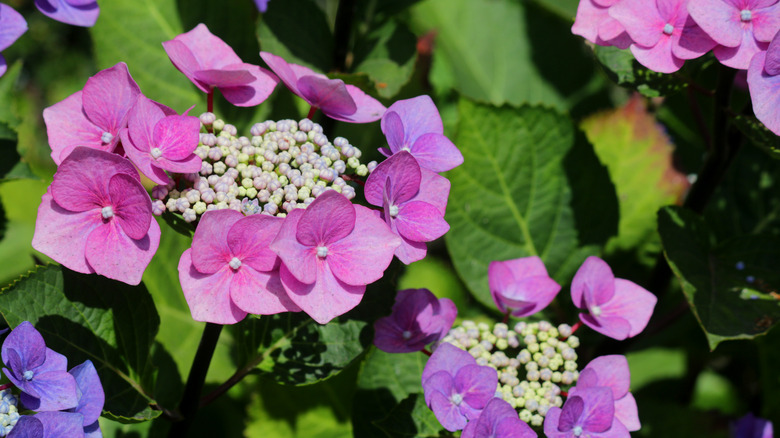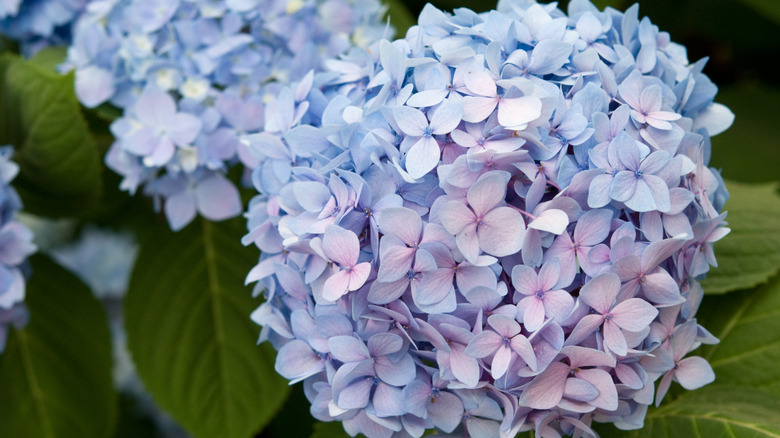4 Types Of Hydrangeas That Can Take On Warmer Climates
Hydrangeas are one of the most popular additions to a home flower garden. Big and bright, they are beautiful both when flowering on their bushes and when cut and displayed in a vase. Hydrangeas are versatile plants that are easy to grow in almost any environment as long as they're placed in well-drained soil. However, there are over 70 different species of hydrangeas, and not all of them thrive in identical conditions. Fortunately, these 70 species can be grouped into five main hydrangea varieties found in North America — Bigleaf, Panicle, Smooth, Oakleaf, and Climbing — and four of these five (all except Climbing) are hardy throughout zones across the warmer climates of the US.
The majority of the US is encapsulated by growth hardiness zones 6 to 9, meaning that the minimum annual temperature rarely gets as low as zero degrees Fahrenheit. Many of these areas, especially in the South and Southwest, experience warmer blossoming periods with more sun and a greater likelihood of drought periods. Therefore, the plants you choose for your gardens here need to be more resistant to these forces to account for the longer blooming season and higher temperatures. Hydrangeas can be planted in heat. They're perennials that go dormant in the winter anyway, but if your winters are mild or particularly short, it's best to have planted hydrangeas that will withstand the warmer weather as they lie dormant for shorter periods of time.
Oakleaf hydrangeas offer low-key beauty and elegance
Named for their visual similarity to the leaves of oak trees, Oakleaf hydrangeas are a beautiful, woodsy addition to any yard. The Oakleaf is a large shrub with deep green leaves that travel across the color spectrum from yellow to purple in the fall. It's native to the Southeast US but is hardy anywhere from zones 5 to 9, making it a potential eye-catcher across most of the country. As for the flowers, they grow in conical shapes in lovely shades of white that develop a slightly blush tint before going dormant. And unlike other hydrangeas, these colors are not influenced by the pH of the soil, meaning they will be consistently white no matter where they're planted.
Oakleaf hydrangeas are heat tolerant and not overly picky about soil, as long as it is well-drained, but they grow best when given morning sunlight and a little afternoon shade, increasing the shade amount as you go further south into the higher zone numbers. Moreover, while they can survive without water until the first several inches of topsoil are dry, they also grow steadily in damper conditions as long as they aren't regularly subjected to standing water. Popular Oakleaf hydrangea varieties are the towering Alice hydrangea (reaching up to 15 feet tall), the medium-sized Snowflake hydrangea (averaging 7 to 8 feet in both height and width), and the compact Pee Wee hydrangea (topping out around 4 feet high).
Smooth hydrangeas bring the wilderness to your yard
Found all along the eastern US, Smooth hydrangeas are known for their giant white spheres of flowers. This shrub tends to grow wider than it is tall, usually not getting higher than about 4 or 5 feet. This height is ideal, however, for layering between trees and wildflowers in a naturalist yard, and the shrubs themselves work wonders stabilizing slopes, making them ideal for hillier ground. They're also known attractors of both songbirds and pollinators, so they're a great addition to butterfly gardens or the lawns of birdwatchers. Their dark green, pointed leaves have a pale yellow underside similar to the color they will produce come fall, while the clusters of blossoms on traditional varieties go from pale green to full white before wilting into a khaki color.
Smooth hydrangeas are more tolerant of cold than other varieties, able to be grown as far north as zone 3, but are also found in native habitats of Florida, proving they survive in the South. They prefer a bit more shade than other hydrangeas as well, though they can be acclimated to extended sun exposure with sufficient watering. Smooth hydrangeas grow best in rich, moist soil that is well-draining. These hydrangeas are not drought-resistant and may need supplemental watering in summer, though they are otherwise fairly easy to maintain, only needing to be pruned once in the off-season to allow bigger and more stunning blooms to grow.
Panicle hydrangeas are the hardiest of them all
Panicle Hydrangeas can thrive just about anywhere, from colder climates to warmer ones, and can withstand the occasional frost as well as direct sunlight. In fact, the only place it won't grow is in full shade, although partial afternoon shade is always welcome. The Panicle hydrangea blooms in large, loose clusters (or "panicles") shaped like teardrops or footballs, while the shrub itself can grow up to 15 feet tall and 12 feet wide. Because of its size, Panicle hydrangeas can also be trained into trees. And while they're mostly found in Asia, these plants can thrive across the US, anywhere from zones 3 to 9. Their leaves go from green to yellow to orange, while their flowers start out a shade of white and then turn pink or red later in the season and wilting beige in the fall, making this a stunning plant year-round.
Panicle hydrangeas are low maintenance, tolerant of both slightly dry and somewhat damp conditions, and require only rich, well-draining soil with moderate watering. They create a huge amount of visual interest without you having to tend to them much at all. However, because the flowers bloom on the wood of its branches, pruning your Panicle hydrangea in late fall or early spring will ensure bigger, brighter, and bolder blossoms come summer.
Lacecap is a Bigleaf hydrangea that's as beautiful and delicate as its name
Bigleaf hydrangeas are separated into two distinct flower types, the first of which is Lacecap. As the name suggests, the shrubs boast giant toothed leaves while the Lacecap's flowers, unlike other hydrangeas, grow in flat patches of lacy flowers surrounded by a ring of single larger blooms. And like its delicate namesake, the Lacecap hydrangea is one of the pickiest varieties in terms of maintenance. They love morning sun and afternoon shade like other hydrangeas, but they require consistently moist, acidic soil and regular watering. These may be fussier than other hydrangeas, but their particular needs, when met, produce some striking results, with petals in varying shades depending on the soil acidity of your garden. More acidic soil will result in pink flowers, while less acidic soil produces blue ones.
Lacecap hydrangeas bloom in the spring and thankfully require little pruning, growing anywhere from 6 to 10 feet in both height and width, doing best in USDA zones 6 to 9. Indeed, Lacecap hydrangeas should be covered or brought inside during cold snaps. Only certain varieties of Lacecap hydrangeas have been cultivated to grow in colder US zones.
Mophead is the Bigleaf Hydrangea we all know and love
Mophead hydrangeas are the shrubs with the large, round, colorful blooms we all think of when hydrangeas are mentioned. As the name suggests, the flowers grow in rounded clusters resembling old mop heads, and they can come in a range of colors from white to pink to blue and everything in between. They are native to the western US and can grow well in warmer climates, though they are rated for zones 4 to 9, meaning almost anywhere in the country. They grow in uniform, rounded shapes of equal height and width, making them a prized favorite for gardens and container planters, perhaps explaining their alternate moniker: Hortensia.
Perfect for butterfly gardens, Mophead hydrangeas bloom from June all the way through September and require minimal pruning. They require moist soil that drains well, have less drought tolerance than other varieties, and will lose buds to frost, making warmer climates ideal for this variety. In addition, they require regular, consistent watering of 1 to 2 inches per week, more in particularly hot and dry conditions. And while they aren't particular to soil pH, the acidity of your soil will impact the color of your blossoms. Add used tea bags to your mulch for pinker shades or baking soda to turn your hydrangeas blue.
